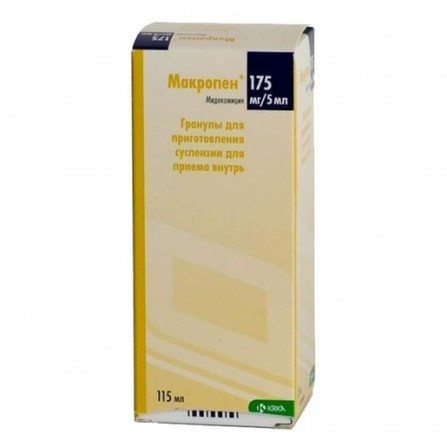Macropen powder for suspension preparation 175mg 5ml 115ml
Condition: New product
996 Items
Rating:
Be the first to write a review!

More info
Active ingredients
Midecamycin
Release form
Powder
Composition
1 dose contains: midekamycin acetate 175 mg / 5 ml
Pharmacological effect
An antibiotic group macrolides. Inhibits protein synthesis in bacterial cells. Reversibly binds to the 50S subunit of the bacterial ribosomal membrane. In low doses, the drug has a bacteriostatic effect, in high doses it is bactericidal. Active against intracellular microorganisms: Mycoplasma spp., Chlamydia spp., Legionella spp., Ureaplasma urealyticum; Gram-positive bacteria: Streptococcus spp., Staphylococcus spp., Corynebacterium diphtheriae, Listeria monocytogenes, Clostridium spp .; Gram-negative bacteria: Neisseria spp., Moraxella catarrhalis, Bordetella pertussis, Helicobacter spp., Campylobacter spp., Bacteroides spp.
Pharmacokinetics
Absorption: After oral administration, midecamycin is rapidly and fairly fully absorbed from the gastrointestinal tract. Serum Cmax of midecamycin and midecamycin acetate are 0.5–2.5 mcg / l and 1.31–3.3 mcg / l, respectively, and are achieved 1–2 hours after ingestion. Distribution: High concentrations of midekamycin and midekamycin acetate are created in the internal organs (especially in the tissues of the lungs, parotid and submaxillary glands) and the skin. BMD lasts for 6 hours. Midecamycin binds to proteins by 47%, its metabolites by 3-29%. Metabolism: Midecamycin is metabolized in the liver to form 2 metabolites with antimicrobial activity. Withdrawal: T1 / 2 is approximately 1 hour. Midecamycin is excreted in the bile and to a lesser extent (about 5%) in the urine. Pharmacokinetics in Special Clinical Cases With liver cirrhosis, plasma concentrations, AUC and T1 / 2 increase significantly.
Indications
Infectious and inflammatory diseases caused by susceptible microorganisms: Respiratory tract infections: tonsillofaringitis, acute otitis media, sinusitis, exacerbation of chronic bronchitis, community-acquired pneumonia (including Caused by atypical pathogens of mycoplasma spp., Chlamydia spp. ureaplasma urealyticum). Urinary system infections caused by mycoplasma spp., chlamydia spp., legionella spp. And ureaplasma urealyticum. Infections of the skin and subcutaneous tissue. Treatment of enteritis caused by campylobacter spp. Treatment and prevention of diphtheria and whooping cough.
Contraindications
Hepatic insufficiency is severe. Heightened sensitivity to midecamycin / midecamycin acetate and other components of the drug. The drug should be prescribed with caution during pregnancy, during lactation, and also in the presence of a history of an allergic reaction to taking acetylsalicylic acid.
Precautionary measures
With caution should be prescribed the drug during pregnancy, during lactation, as well as if there is a history of an allergic reaction to taking acetylsalicylic acid.
Use during pregnancy and lactation
The use of Macropen during pregnancy is possible only when the intended benefit to the mother outweighs the potential risk to the fetus. Midecamycin is excreted in breast milk. When using Macropen during lactation, breastfeeding should be stopped.
Dosage and administration
Adults and children weighing more than 30 kg are prescribed Macropen 400 mg (1 tab.) 3 times / day. The maximum daily intake for adults is 1.6 g. For children weighing less than 30 kg, the daily dose is 20–40 mg / kg body weight in 3 doses or 50 mg / kg body weight in 2 doses, for severe infections, 50 mg / kg body weight in 3 doses. Scheme of Macropena in the form of a suspension for children (daily dose of 50 mg / kg body weight in 2 doses): Body weight (approximately age) Suspension (175 mg / 5 ml) to 5 kg (approx. 2 months) at 3.75 ml (131.25 mg) 2 times / day up to 10 kg (approx. 1-2 years) at 7.5 ml (262.5 mg) 2 times / day up to 15 kg (approx. 4 years) at 10 ml (350 mg) 2 times / day up to 20 kg (approx. 6 years) in 15 ml (525 mg) 2 times / day to 30 kg (approx. 10 years) in 22.5 ml (787.5 mg) 2 times / day
Side effects
On the part of the digestive system, decreased appetite, stomatitis, nausea, vomiting, diarrhea, a feeling of heaviness in the epigastrium, increased activity of hepatic transaminases and jaundice. in some cases, severe and prolonged diarrhea, which may indicate the development of pseudomembranous colitis. Allergic reactions skin rash, urticaria, pruritus, eosinophilia, bronchospasm. Other weakness.
Overdose
There are no reported cases of serious intoxication caused by the use of the drug Macropen. Symptoms: possible nausea, vomiting. Treatment: symptomatic treatment.
Interaction with other drugs
With simultaneous use of Macropen with ergot alkaloids, carbamazepine, their metabolism in the liver decreases and serum concentration increases. Therefore, with the simultaneous appointment of these drugs should be careful. With simultaneous use of Macropen with cyclosporine, anticoagulants (warfarin), excretion of the latter is slowed down. Macropene does not affect the pharmacokinetic parameters of theophylline.
special instructions
As with the use of any other antimicrobial drugs, with long-term treatment with Macropen, excessive growth of resistant bacteria is possible. Prolonged diarrhea may indicate the development of pseudomembranous colitis. With prolonged therapy, liver enzyme activity should be monitored, especially in patients with impaired liver function. The mannitol contained in the granules for suspension may cause diarrhea. If you have a history of an allergic reaction to the intake of acetylsalicylic acid, the azo dye E110 (sunset sunflower yellow dye) can cause an allergic reaction up to bronchospasm. Effects on the ability to drive vehicles and control mechanisms: Not reported on the effect of Macropene on the speed of psychomotor reactions and the ability to drive a car and other mechanisms.





